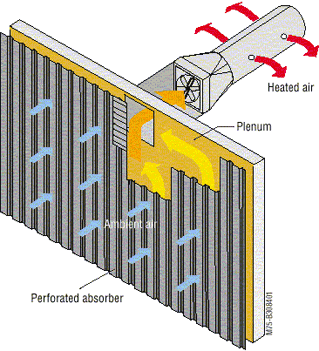transpired air collector

A transpired air collector preheats air for building ventilation by using a fan to draw fresh air through the system. Outside (ambient) air passes through holes in the collector (absorber) and is heated as it is drawn up the air space (plenum) between the collector and the south wall of the building.
A transpired air collector is a device that uses the sun's energy to heat cold outside air for use in buildings. In so doing, it reduces the amount of space heating needed to keep buildings comfortable on cold days. Because transpired air collectors dramatically reduce utility bills, they can pay for themselves in just a few years. This new technology provides an effective means for substituting renewable energy for fossil fuel consumption, particularly in cold climates.
How they work
Transpired air collectors use a simple, elegant technology to capture the sun's heat to warm buildings. The collectors consist of dark, perforated metal plates installed over a building's south-facing wall. An air space is created between the old wall and the new facade. The dark outer facade absorbs solar energy and rapidly heats up on sunny days – even when the outside air is cold.
A fan or blower draws ventilation air into the building through hundreds of tiny holes in the collectors and up through the air space between the collectors and the south wall. The solar energy absorbed by the collectors warms the air flowing through them by as much as 40°F.
Unlike older space heating technologies, transpired air collectors require no expensive glazing, which caused energy loss due to reflection. The lack of glazing, together with design refinements, allow the new collectors to capture a remarkable 80% of available solar energy.
Advantages of transpired air collectors
Transpired air collectors have many advantages. They are the most efficient solar collectors in the world. They pay for themselves quickly and produce environmental and economic benefits with no negative side effects. They are suitable for many large buildings.
Transpired air collectors are virtually maintenance free and contain no moving parts other than the ventilation system fans. At night, they reduce the amount of heat escaping from buildings by recapturing heat lost through the building wall behind the collectors. Transpired air collectors also help improve indoor air quality because good ventilation is an integral part of the system.
Transpired air collectors are versatile. They can be added to existing buildings or designed as part of a new building's facade. Commercial transpired air collectors use attractive metal sheeting and are available in many colors. When used in new construction, "solar walls" can save money on the building's facade. They pay for themselves even faster when installed in new buildings than when they are retrofitted to existing ones.
Transpired air collectors are easier to use, cost less, and are more efficient than older solar air collectors made with glazing. Their installation is simple. They require fewer materials. And they absorb more solar energy, making them more efficient.
Transpired air collectors reduce the amount of energy needed for space heating in cold climates. Lower energy requirements translate into reduced building operation costs and less reliance on fossil fuels such as natural gas, heating oil, and coal. To the extent renewable energy replaces fossil fuels, there are fewer emissions of pollutants and greenhouse gases.
Disadvantages
There are few disadvantages to using transpired air collectors. However, some multistory buildings have fire codes that make transpired collectors impractical. Existing heat-recovery systems in some buildings may also be incompatible with transpired air collectors.
Applications
Transpired air collectors are recommended for industrial or commercial buildings with large ventilation requirements. They work best in sunny locations on buildings that have a large south-facing wall for mounting the collectors. They have the greatest impact on heating costs in regions with long heating seasons and high fuel prices.
Transpired air collectors are easily combined with most standard ventilation systems in existing buildings. Collectors can also be designed as part of a new building's facade.
Transpired air collectors are an affordable option for many buildings with high space heating costs that do not currently heat outside air for indoor use. They are most cost effective in buildings with a south-, southeast-, or southwest-facing wall; in colder climates; in buildings with high utility rates for heating; and in buildings requiring a lot of ventilation.
Both the public and private sectors use transpired air collectors to reduce building heating costs. The Fort Carson Army Base in Colorado was the first federal facility to install a "solar wall" on one of its buildings. Ford Motor Company, McDonnell Douglas, General Motors Corporation, and Federal Express are some of the private companies that use transpired air collectors to help heat buildings. Common applications include manufacturing plants, apartment buildings, vehicle maintenance facilities, hazardous waste storage buildings, gymnasiums, airplane hangars, schools, and warehouses.
Transpired air collectors can also preheat combustion air for central-heating plants or industrial furnaces. The food processing industry uses them for crop drying.
